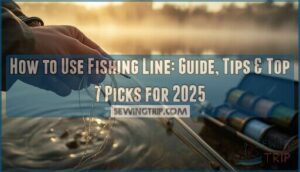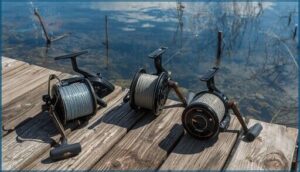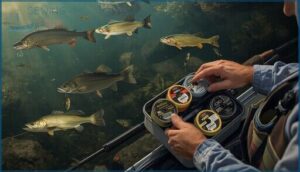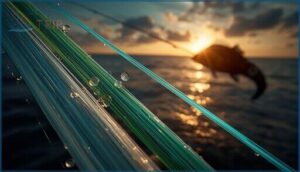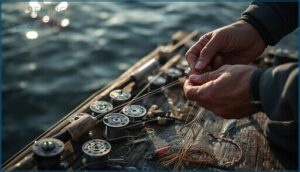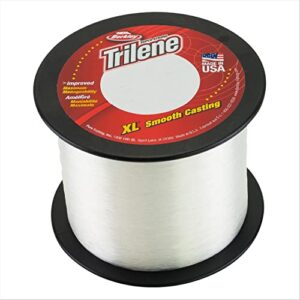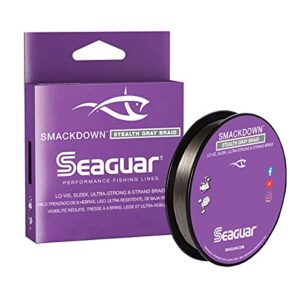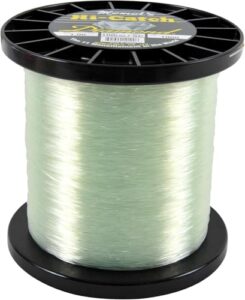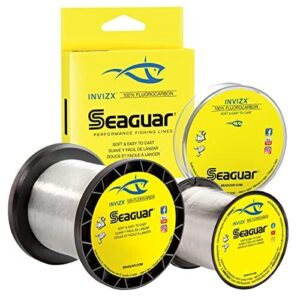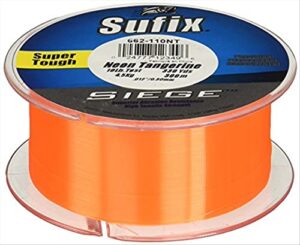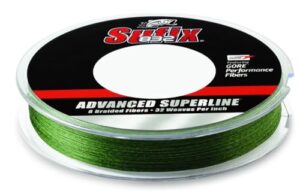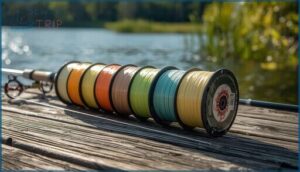This site is supported by our readers. We may earn a commission, at no cost to you, if you purchase through links.
If you’ve ever watched a seasoned angler land a trophy bass, you’ll notice something: every move, from casting to reeling, hinges on their choice of fishing line. The difference between a clean hookset and a lost catch often comes down to how you handle the line itself.
Water clarity, fish behavior, and even the knot you tie can all tip the odds in your favor—or leave you untangling a mess. With fishing line, the details matter, whether you’re matching pound test to target species or choosing a spool that won’t spook wary trout.
Mastering these details transforms frustration into confidence on the water.
Table Of Contents
Key Takeaways
- Choosing the right fishing line type and strength depends on your target species, water clarity, and fishing technique.
- Proper spooling, knot tying, and storage habits are crucial for preventing tangles, maximizing line life, and ensuring reliable performance.
- Budget-friendly lines can offer strong value, but regular replacement and attention to UV damage are important for maintaining effectiveness.
- Discarded fishing line poses serious environmental risks, so recycling and considering eco-friendly alternatives help protect waterways and wildlife.
How to Choose The Right Fishing Line
Choosing the right fishing line can make or break your day on the water. There are a few key factors to think about before you spool up your reel.
Let’s walk through what you need to know to pick the best line for your next trip.
Monofilament Vs. Fluorocarbon Vs. Braided
When you’re weighing fishing line types, each brings its own set of fishing line characteristics to the table. Monofilament offers solid knot strength and line stretch, but stands out in visibility. Fluorocarbon excels at abrasion resistance and low visibility. Braided lines, thanks to their weaving, deliver peerless strength and fast sinking rate. One key factor is how fishing conditions affect your line choice.
- Line visibility
- Knot strength
- Abrasion resistance
- Line stretch
- Sinking rate
Matching Line to Target Fish Species
Matching your fishing line to the species you’re chasing isn’t just about pound test—it’s about understanding species behavior, rod action, and lure presentation. For instance, fishing line for bass means braided strength for heavy cover, while fishing line for trout favors fluorocarbon’s stealth. Choosing the correct line also depends on the fishing line weight for best results.
Here’s a quick comparison:
| Species | Recommended Line Type |
|---|---|
| Bass | 15-20 lb Braided |
| Crappie | 2-6 lb Monofilament |
| Trout | 6-8 lb Fluorocarbon |
| Walleye | 10-15 lb Braided |
| Pike/Muskie | 30-50 lb Braided |
Water Clarity and Line Visibility
If you’re after wary fish, water clarity and line visibility can make or break your catch rates. Fluorocarbon fishing line, with its low refractive index, stays nearly invisible in clear water, while monofilament fishing line and braid stand out more.
Species sensitivity and changing light conditions mean color effectiveness shifts—green blends in vegetation, pink shines in low light.
Line Strength and Pound Test Guidelines
Visibility matters, but line strength is your safety net. Pound test ratings show the weight a line can handle, yet breaking strength variance is common—some lines snap well above or below their label.
IGFA standards allow a margin, so practical up-sizing is wise when species targeting. Always check line efficiency and follow fishing line strength guidelines for types of fishing line.
Fishing Techniques and Line Selection
When you’re choosing fishing line, think about how your technique shapes your results. Spinnerbaits call for monofilament in most cases, but braided lines excel in thick vegetation—classic Technique Adaptations.
For Species-Specific Lines, bass and trout demand different pound tests and Fishing Line Types.
Line Color Impact matters too; clear or green blends best depending on water clarity and your Fishing Line Selection.
Essential Tips for Using Fishing Line
Getting the most out of your fishing line starts with a few practical habits. If you want smoother casts and fewer headaches on the water, a little know-how goes a long way.
Here’s what you’ll want to keep in mind before your next trip.
How to Spool Your Reel Correctly
Ever wondered why your spinning reel tangles up right when the bite heats up? Mastering how to spool your reel is essential. You need steady line tension, proper spool filling, and sharp attention to avoiding twists. Here’s how to keep your fishing line ready:
- Secure the line with the right knot
- Maintain even tension
- Stop 1/8″ from spool rim
Tying Strong Fishing Knots
How do you make sure your knot holds when it counts? Start with knot tying techniques that boost knot strength retention, like the Palomar knot, which keeps up to 89% of monofilament’s strength.
Remember, knot failure causes often trace back to poor technique, not the knot itself. Practicing knots on different line materials helps you master fishing line knots for every scenario.
Handling and Storing Fishing Line
Did you know that improper Fishing Line Storage can cut your line’s life in half? For proper handling and best storage, follow these steps:
- Store in a cool, dark place.
- Use airtight containers.
- Rinse saltwater residue.
- Inspect for nicks and coils.
- Remove damaged line for recycling.
Fishing Line Care isn’t just about longevity—it’s about safety and environmental impact.
Avoiding Line Twists and Tangles
Tangles aren’t just annoying—they’ll cost you fish. Keep a steady Spooling Tension when loading your spool, as loose line twists fast.
Choose reliable Swivel Choices and always use strong fishing knots; poor Knot Impact causes most snarls.
Reel Habits matter too: close your spinning reel bail manually and avoid cranking while drag slips.
When needed, try time-tested Remediation Tactics.
Top 7 Fishing Lines for Every Angler
With so many fishing lines on the market, it’s easy to feel overwhelmed by the choices. Each one has its own strengths and ideal uses, depending on how and where you fish.
Here are seven top picks for dependable performance every time you hit the water.
1. Berkley Trilene XL Clear Fishing Line
Berkley Trilene XL stands out as a standard among the best fishing lines, blending easy casting with impressive wet strength and knot strength. If you want a line that disappears underwater but holds firm on the strike, this monofilament checks the boxes for line visibility and manageability.
User reviews highlight its consistent market position and decades-long reliability. For beginners and seasoned anglers alike, Trilene XL combines smooth casting and strong performance, making it a staple in fishing line reviews year after year.
Best For: Anglers looking for a smooth-casting, low-visibility line that’s durable, easy to manage, and trusted for years in freshwater fishing.
- Smooth casting with strong knot and wet strength for fewer tangles and secure holds
- Clear design makes the line nearly invisible to fish in freshwater environments
- Reliable reputation and user satisfaction from decades of proven performance
- Some line memory, especially if used with spinning reels, can cause tangles
- Clear color can be hard to see above water for anglers
- Not ideal for situations requiring high-visibility fishing line
2. Seaguar Smackdown Low Visibility Braid Line
If you’re looking for a braided fishing line that combines low visibility with impressive knot strength, Seaguar Smackdown stands out. Its ultra-thin diameter and tight eight-strand weave mean you get superb casting distance and reel compatibility, especially when finesse matters.
The Stealth Gray color helps reduce braid visibility in clear water, letting your lure do the talking. Anglers report smooth handling and minimal fraying, even around rocks.
For those who prioritize sensitivity and reliability, Smackdown’s performance is tough to beat.
Best For: Anglers who fish clear freshwater or marshy ponds and want a strong, low-visibility braided line for finesse and reliable performance.
- Virtually no stretch, so you feel even the lightest bites.
- Outstanding knot strength and abrasion resistance.
- Thin diameter lets you spool more line and cast farther.
- Only available in Stealth Gray, limiting color choices.
- May fray if not handled properly or when rubbing against sharp rocks.
- Not ideal for saltwater or extreme weather conditions.
3. Power Pro Braided Fishing Line
When you want strength and sensitivity in one package, Power Pro braided fishing line sets the standard. Its braid construction and Spectra fibers deliver near-zero stretch and excellent abrasion resistance, even in rough cover. The thin line diameter means more action and longer casting distance, while knot strength holds up under pressure.
Fishing line reviews consistently praise PowerPro for reliability, whether you’re targeting bass or panfish. If you need a braided fishing line that’s tough, smooth, and adaptable, Power Pro is a smart choice.
Best For: Anglers who want a strong, sensitive braided line that performs well in both freshwater and saltwater, from bass fishing to finesse techniques.
- Excellent strength and abrasion resistance for fishing around rocks, cover, or debris
- Near-zero stretch for better sensitivity and hook-setting power
- Thin diameter allows for longer casts and more lure action
- Can cause cuts if handled carelessly, especially under tension
- Prone to wind knots and tangling in lighter line weights
- May fray or break if not checked regularly, especially after contact with sharp objects
4. Momoi High Catch Fishing Line
If you’re after a monofilament that stands up to the toughest battles, Momoi HiCatch Diamond is worth a close look. Offshore anglers trust its abrasion resistance and knot strength, especially when targeting big game species.
The clear Diamond color boosts line visibility, while spool sizes run from lightweight to heavy-duty. Fishing line reviews point out its reliability under pressure, and you’ll find it holds up when fishing near rocks or sharp objects.
Among fishing line brands, Momoi delivers performance that’s hard to ignore.
Best For: Offshore anglers and big game hunters who need a tough, reliable monofilament line for extreme fishing conditions.
- Superior abrasion resistance keeps the line strong around rocks and rough fish.
- High knot strength and minimal memory make rigging and casting smooth.
- Wide range of sizes and colors suits everything from light tackle to heavy offshore gear.
- May show nicks and scratches after fighting large fish, affecting appearance.
- Stiffer feel compared to some softer monofilaments.
- Limited long-term durability information available.
5. Seaguar Invizx Clear Fluorocarbon Line
If Momoi sets the bar for durability, Seaguar InvizX Clear Fluorocarbon Line raises the standard for stealth and reliability. This Fluorocarbon Line excels in Abrasion Resistance and Underwater Visibility, making it a favorite for fishing in clear water.
You’ll notice its Knot Strength holds steady, even after repeated reties, and Casting Performance often means longer, smoother throws.
Fishing line reviews consistently praise InvizX for its low Diameter Variance and reliable pound-test ratings—giving you confidence whether you’re chasing bass or trout.
Best For: Anglers who need a tough, nearly invisible line for clear water and finesse fishing, especially when targeting wary fish like bass and trout.
- Outstanding abrasion resistance for fishing around rocks and structure
- Virtually invisible underwater, boosting bites in clear conditions
- Reliable knot strength and smooth casting performance
- May distort under heavy strain or extreme pressure
- Can darken with use, slightly reducing invisibility over time
- Occasional line twist issues when spooling, requiring extra attention
6. Sufix Siege Tangerine Fishing Line
With Sufix Siege Tangerine, you get a fishing line that stands out for its impressive Abrasion Resistance and reliable Knot Strength. This line tackles rocks and brush without flinching, and its smooth finish delivers up to 20% better Casting Distance than most fishing line brands.
Thanks to G² Precision Winding, Line Memory is virtually eliminated—making it a favorite in fishing line reviews. Durability tests show it holds up season after season, so it’s a practical choice for beginners and seasoned anglers alike.
Best For: Anglers who fish in heavy cover or rocky areas and want a tough, easy-handling line with great casting distance.
- Outstanding abrasion resistance for fishing around rocks, brush, and weeds
- Virtually no line memory, making it easy to handle and less likely to tangle
- High knot strength and smooth casting for reliable performance
- Neon tangerine color may be too bright or distracting for some users
- Can be hard to find in stores due to limited availability
- May not suit every fishing style or water condition
7. Sufix 832 Braid Low Vis Green
For anglers who demand more from their braided line, the Sufix 832 Superior Superline stands out. Its unique braid construction—eight fibers woven with precision—delivers unbeatable abrasion resistance and consistent knot strength.
You’ll notice improved casting distance and reliable color retention, especially in the Low Vis Green variant.
Whether you’re fishing for musky or saltwater species, this braided line’s thin diameter and hydrophobic coating keep performance steady. Fishing line reviews consistently rank Sufix 832 among the top choices for durability and reliability.
Best For: Anglers who want a strong, smooth-casting braided line that holds up in tough conditions, from freshwater to inshore saltwater fishing.
- Outstanding abrasion resistance and knot strength for fewer break-offs
- Smooth, long casts thanks to precision braiding and GORE Performance Fiber
- Maintains strength and roundness even after months of heavy use
- Color fades faster than expected, especially in saltwater
- Can be prone to wind knots if not managed carefully
- Requires regular maintenance to prevent fraying and vibration
Budget-Friendly Fishing Line Options
Fishing doesn’t have to drain your wallet, especially when choosing the right line. You’ll find plenty of solid options that balance price and performance.
Let’s take a closer look at some fishing lines that offer real value for your money.
Affordable Monofilament Choices
Did you know budget line strength often beats the label? If you’re weighing beginner mono options, spooling bulk mono like Berkley Trilene XL keeps fishing line cost low and knot strength high. Just remember, monofilament UV degradation is real—replace your best fishing lines often.
Here are three smart picks:
- Berkley Trilene XL
- Sufix Pro Mix
- Stren Original
Cost-Effective Braided Lines
Ever wondered why braid outlasts mono, even on a tight budget? You get more bang for your buck with budget brands like PowerPro Spectra and Sufix 832 Superline. Their slim diameter ratios boost casting, and knot compatibility means fewer headaches. Pair these with a quality reel for a braid lifespan that justifies the fishing line cost.
| Brand | Diameter Ratio | Best Reel Pairing |
|---|---|---|
| PowerPro Spectra | 0.23 mm/20 lb | Spinning/Baitcaster |
| Sufix 832 | 0.20 mm/15 lb | Spinning |
| Daiwa J-Braid X8 | 0.24 mm/20 lb | Baitcaster |
Finding Value in Fluorocarbon Lines
Looking for smart value in fluorocarbon? You’re investing in a fishing line that’s nearly invisible in clear water, with reliable abrasion resistance and first-rate bite detection. The upfront cost might seem steep, but a longer line lifespan and enhanced UV resistance mean fewer replacements.
For fishing techniques where clarity and durability matter, cost analysis consistently favors fluorocarbon’s performance over time.
Environmental Impact of Fishing Line Use
Fishing line has a bigger impact on the environment than most anglers realize. If you’re curious about the risks and your role in protecting waterways, you’re in the right place.
Here are some key things to keep in mind before you head out.
Dangers of Discarded Fishing Line
Did you realize discarded fishing line can circle the planet 18 times each year? That’s not just trivia—it’s a warning.
Discarded fishing line could wrap around the Earth 18 times each year—a staggering reminder of its environmental impact
Consider these impacts:
- Wildlife entanglement kills over 100,000 marine mammals annually.
- Microplastic pollution from fishing line persists for centuries.
- Ecosystem damage disrupts coral reefs and fish populations.
- Economic costs from cleanup and gear loss burden communities.
Prevention strategies matter.
Proper Disposal and Recycling Tips
If you’re serious about fishing tips and guides, proper disposal is part of the craft. Anglers should prep used line—remove all accessories, cut it under six inches, and keep it clean. Most marinas and tackle shops offer recycling bin locations, but remember: only monofilament and fluorocarbon are accepted. DIY disposal bins and regulatory initiatives help keep harmful fishing line accessories out of waterways.
| Recycling Bin Locations | Line Preparation Steps |
|---|---|
| Marinas, piers, parks | Remove hooks, lures |
| Tackle shops | Cut line < 6 inches |
| Boat ramps | Clean line thoroughly |
| DIY disposal bins | Store in containers |
Eco-Friendly Fishing Line Alternatives
If you’re already recycling your fishing line, consider eco-friendly alternatives for your next purchase. Biodegradable materials like plant-based polymers and recycled nylon are gaining traction among anglers and fishing line brands. These innovations offer solid performance metrics while supporting wildlife protection and market adoption.
Here are four options:
- Biodegradable monofilament
- Recycled nylon lines
- Bio-polyester products
- Clear biodegradable lures
Frequently Asked Questions (FAQs)
How often should fishing line be replaced?
Imagine reeling in a big bass after months of storage—only to snap your line. Line degradation, saltwater effects, and usage indicators mean most fishing lines need annual replacement, though shelf life and storage impact durability and angling experience.
Can fishing line be recycled or safely disposed of?
You can recycle fishing line through specialized line recycling programs, but don’t toss it in regular bins. Safe disposal methods—like cutting line into short segments—help prevent wildlife entanglement and microplastic pollution. Biodegradable alternatives are emerging for eco-minded anglers.
Whats the best way to store fishing line?
Keep your spool in a cool, dark place below 70°F, with humidity under 50%. Use airtight containers to block UV exposure and moisture.
This extends shelf life, keeping fishing line strong for reliable fishing line spooling and accessories.
How does water temperature affect fishing line performance?
Frigid or fiery water can seriously shift line tensile strength and casting distance. Warm water softens monofilament, hurting abrasion resistance and knot strength impact, while cold stiffens it, reducing handling performance.
Braided and fluorocarbon lines stay durable and consistent.
Are there eco-friendly alternatives to traditional fishing lines?
Yes, eco-friendly alternatives exist—biodegradable materials are gaining ground in fishing line design.
Market adoption is growing, with plant-based monofilament and braid offering solid performance, environmental benefits, and support from recycling programs for responsible angling.
Can fishing line be reused after breaking?
Before you cast again, know that line strength loss and knot failure risk both spike after a break. Reversing braided line helps, but durability of fishing lines drops.
Reuse safety protocols and environmental considerations matter—choose wisely for fishing challenges ahead.
What causes fishing line to degrade over time?
UV exposure, chemical contact, abrasion damage, and poor storage conditions all weaken fishing line over time. Temperature effects, sunlight, and repeated use break down the durability of fishing lines, even abrasion-resistant or braided types, reducing performance and reliability.
Is fishing line safe for freshwater aquarium use?
Picture a clear tank—peaceful, but introduce fishing line and you face line chemical leaching, physical entanglement risks, and subtle water chemistry effects.
Still, with safe usage practices, reported aquarium incidents in freshwater remain rare for most species and fish.
How does temperature affect fishing line performance?
Temperature swings—cold weather or heat exposure—can impact fishing line durability. Monofilament stiffens and coils in the cold, while heat and UV rays reduce tensile strength.
Always follow manufacturer guidelines to maintain line memory and performance for reliable fishing.
Are there fishing lines designed for ice fishing?
Ever wondered how anglers keep their lines supple in freezing conditions? Specialized ice fishing lines offer ice-line suppleness, cold-water visibility, freeze-up prevention, abrasion resistance, and reliable knot strength, making them essential fishing gear for cold-weather fishing techniques and beginners alike.
Conclusion
Hook, line, and thinker—success with fishing line isn’t just about gear, but understanding how every choice shapes your experience. Whether you’re casting for bass or trout, matching line type and strength to conditions gives you control.
From spooling reels to selecting eco-friendly options, each step builds your confidence and skill. Remember, with fishing line, the smallest detail can make the biggest difference.
Treat your line well, and it’ll always keep you connected to the catch.
- https://www.worldwildlife.org/resources/explainers/ghost-fishing-gear/
- https://www.csiro.au/en/news/all/articles/2022/october/abandoned-fishing-gear
- https://phys.org/news/2022-10-km-fishing-line-billion-lost.html
- https://caseagrant.ucsd.edu/news/reducing-fishing-line-pollution-one-recycling-bin-time
- https://www.verifiedmarketreports.com/product/fishing-line-market/

